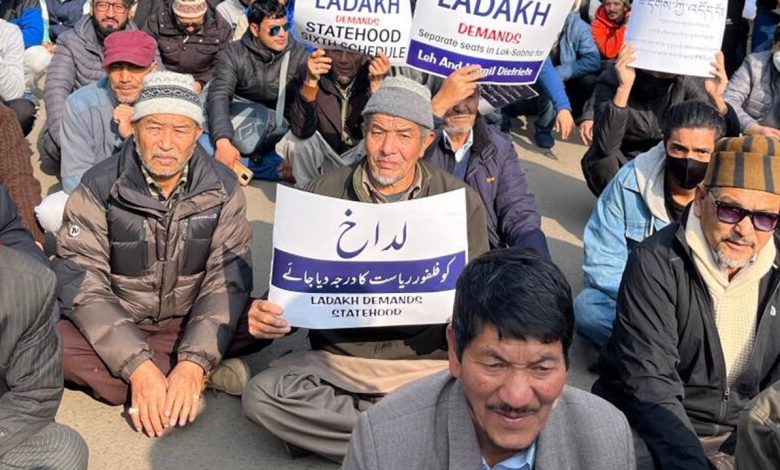Daily Current Affairs for UPSC
Demand of Sixth Schedule in Ladakh
Syllabus- Government Policies and Interventions [GS Paper-2]

Context- Recently, Ladakhi innovator and engineer Sonam Wangchuk completed his five-day “climate fast”, for demand of Sixth Schedule in Ladakh.
Key Highlights: Demand of Sixth Schedule in Ladakh
- The fast was held by Mr. Wangchuk in an effort to draw the attention of Indian leaders to the region’s fragile ecology and also to secure its protection under the Sixth Schedule of the Constitution.
Issue of Ladakh’s fragile Ecology
- Ladakh and the Himalayas form the ‘third pole’ of the world and they are among its few frozen freshwater sources.
- The Himalayas, along with all glaciers and river basins, are called the “water tower of Asia”.
- People of the region depend on glaciers in order to fulfill their water needs.
Melting glaciers of Ladakh:
-
- Ladakh is a cold desert and it is extremely sensitive to climate change.
- Glaciers in Ladakh have been melting at an alarming rate.
- As per a study published in 2021, glaciers in the Pangong region retreated around 6.7% between 1990 and 2019.
- The melting of glaciers has certain effects on the lives of Ladakh’s people such as
- Water scarcity:
- They lose potable water;
- Agriculture practices specific to the region are threatened; and
- Sustainable practices that support life in the region, like surviving on a minimal quantity of water, are slowly eroded.
- Loss of livelihood and culture:
- Loss of sustainable practices due to scarcity of water may affect the livelihoods of locals and their cultural heritage, and force them to migrate.
- Loss of biodiversity:
- A change in the ecological balance of Ladakh will impact the biodiversity of the area.
- The flora and fauna of Ladakh are highly evolved to survive in harsh climatic conditions and will be threatened because of changes in the local ecosystems.
- Collapsing ecosystem:
-
- Even the slightest disturbances in an ecosystem as fragile as Ladakh can lead to the collapse of the whole ecosystem.
Potential challenges
- Excessive rainfall:
-
-
- According to experts, it is possible climate change will lead to excessive rainfall in Ladakh by around 2045 because of global warming.
- A rise in temperature has a direct impact on precipitation in an area, which changes agriculture practices. This eventually affects food security.
-
- Uncontrolled development:
-
- Unabated development in sensitive areas like Ladakh, without keeping in mind the sustainable practices which have supported life under extreme conditions, will eventually lead to disruption of the area’s ecology.
- It may lead to land subsidence like we recently witnessed in Joshimath since Ladakh is even more fragile than Chamoli district.
Ladakh’s demand of Sixth Schedule
- After the special status was removed, several political groups in Ladakh have been demanding that land, employment, and the cultural identity of Ladakh, should be protected under the Sixth Schedule.
Issues faced by Ladakh:
- No decentralization of power:
-
-
- There had been four MLAs from the region in the erstwhile J&K Assembly; the administration of the region is completely in the hands of bureaucrats.
- To many in Ladakh, the government looks even more distant than Srinagar.
-
- Changed domicile policy in Jammu and Kashmir:
-
-
- Also, the changed domicile policy in Jammu and Kashmir has shown fears in the region about its own land, employment, demography, and cultural identity.
-
- Limited Finances:
-
- The UT has two Hill councils in Leh and Kargil, but none of them is under the Sixth Schedule.
- Their powers are limited to collection of some local taxes like parking fees and allotment and use of land vested by the Centre.
Recommendations:
-
- Recommendation of the National Commission for Scheduled Tribes:
- In September 2019, the National Commission for Scheduled Tribes recommended the inclusion of Ladakh under the Sixth Schedule.
- The Commission took note of the fact that the newly created Union Territory of Ladakh is predominantly a tribal region in India.
- Recommendation of the National Commission for Scheduled Tribes:
- Report highlights of the Parliamentary Standing Committee:
-
- The Parliamentary Standing Committee on Home Affairs tabled a report in the Rajya Sabha.
- The report stated that, according to the 2011 Census, the tribal population in the Union Territory of Ladakh is 2,18,355, that is 79.61% of the total population of 2,74,289.
- The committee recommended that special status may be granted to the Union Territory of Ladakh considering the developmental needs of the tribal population.
- The Committee further recommends that the possibility of including Ladakh in the fifth or sixth Schedule may be examined.
The Sixth Schedule
- The Sixth Schedule under Article 244 provides for the formation of autonomous administrative divisions — Autonomous District Councils (ADCs) — which have some legislative, judicial, and administrative autonomy within a state.
- Application:
- The Sixth Schedule applies to the Northeastern states of Assam, Meghalaya, Mizoram with three Councils each, and Tripura with one Council.
Autonomous District Councils (ADCs)
- The councils have up to 30 members with a term of five years.
- They can make laws, rules and regulations regarding land, forest, water, agriculture, village councils, health, sanitation, village- and town-level policing, inheritance, marriage and divorce, social customs and mining, etc.
- Exception:
- The Bodoland Territorial Council in Assam is an exception with more than 40 members and the right to make laws on 39 different issues.





.png)



